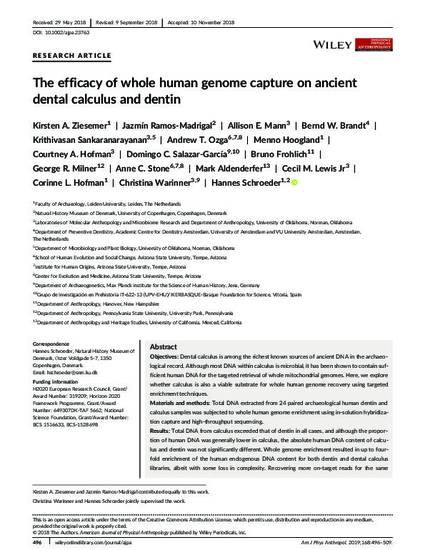
- ancient DNA,
- genomics,
- hybridization capture,
- target enrichment
Objectives
Dental calculus is among the richest known sources of ancient DNA in the archaeological record. Although most DNA within calculus is microbial, it has been shown to contain sufficient human DNA for the targeted retrieval of whole mitochondrial genomes. Here, we explore whether calculus is also a viable substrate for whole human genome recovery using targeted enrichment techniques. Materials and methods
Total DNA extracted from 24 paired archaeological human dentin and calculus samples was subjected to whole human genome enrichment using in‐solution hybridization capture and high‐throughput sequencing. Results
Total DNA from calculus exceeded that of dentin in all cases, and although the proportion of human DNA was generally lower in calculus, the absolute human DNA content of calculus and dentin was not significantly different. Whole genome enrichment resulted in up to four‐fold enrichment of the human endogenous DNA content for both dentin and dental calculus libraries, albeit with some loss in complexity. Recovering more on‐target reads for the same sequencing effort generally improved the quality of downstream analyses, such as sex and ancestry estimation. For nonhuman DNA, comparison of phylum‐level microbial community structure revealed few differences between precapture and postcapture libraries, indicating that off‐target sequences in human genome‐enriched calculus libraries may still be useful for oral microbiome reconstruction. Discussion
While ancient human dental calculus does contain endogenous human DNA sequences, their relative proportion is low when compared with other skeletal tissues. Whole genome enrichment can help increase the proportion of recovered human reads, but in this instance enrichment efficiency was relatively low when compared with other forms of capture. We conclude that further optimization is necessary before the method can be routinely applied to archaeological samples.
Available at: http://works.bepress.com/andrew-ozga/20/

© 2018 The Authors. American Journal of Physical Anthropology published by Wiley Periodicals, Inc.
This is an open access article under the terms of the Creative Commons Attribution License, which permits use, distribution and reproduction in any medium, provided the original work is properly cited.